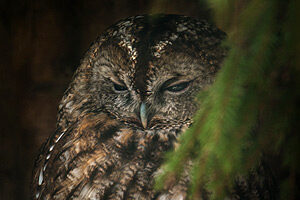Where do they live? As the name of the species in Latvian (Forest owl) signifies, this owl most commonly occurs in sparse coniferous and deciduous forests, parks, cemeteries, alleys, various mosaic landscapes, but mainly in the areas where old trees with hollows occur. It is also rather commonly noticed in the vicinity of residential areas.
How do they live? Since tawny owls are mainly active at night, during the day they usually sit on a branch of a tree close to the trunk and snooze. Such snoozing owls are frequently detected by other birds, who try to chase away their predators; however, most of their attempts are ignored. The voices and shouts of tawny owls can be heard all year long, but they become most intensive during the mating period.
Tawny owls do not make nests themselves, they try to use dens or nests that have been built by others (squirrels and other larger birds), hollow trees, niches of buildings, eaves of houses or large bird boxes.
What do they eat? Tawny owls are predators with small rodents being their basic food source. They also eat shrews, moles, leverets, squirrels, sparrow-like birds, frogs, lizards, snails, beetles, worms. When hungry, they can feed on carrion.
Did you know?
Tawny owls are better at hearing sounds that come from behind. They are the only owl to have something similar to ear conchae - the ears of the owl are surrounded with special skin flaps that, in turn, are covered with hard feathers, which ensure better perception and conduct of sound. All this structure is encased by a fan-shaped arrangement of feathers in front of the ear holes around the eyes of the owl.
How do tawny owls differ from other owls? In comparison with other strigiformes, the tawny oil has straighter wings, which are flapped considerably less frequently. Furthermore, they fly much higher from the ground. The flight itself is rather ponderous, especially at take-off. Nevertheless, it is silent like with other owls.

